Yeast Modified to Thrive on Novel Nutrients
Nutrient assimilation is the first step that allows biological systems to proliferate and produce value-added products. Therefore, efforts in synthetic biology and metabolic engineering have largely focused on rationally designing regulatory infrastructures around biosynthetic/anabolic pathways.
Current efforts to engineer nutrient assimilation pathways take a straightforward approach of over expressing catabolic pathway enzymes without regard for how that integrates into the larger cellular infrastructure that encompasses central metabolism, stress-responses, cell doubling, etc.
In stark contrast, natural systems often use genome-scale regulatory infrastructures, called regulons, to coordinate nutrient catabolism with other cellular functions.
Now, scientists at the Tufts University have created a genetically modified yeast that can more efficiently consume a novel nutrient, xylose, enabling the yeast to grow faster and to higher cell densities, raising the prospect of a significantly faster path toward the design of new synthetic organisms for industrial applications.
“Instead of building a metabolic framework from the ground up, we can reverse engineer existing regulons to enable an organism to thrive on a novel nutrient,” Nikhil Nair, PhD, an assistant professor of chemical and biological engineering at Tufts and corresponding author of this study, said in a statement. “Adapting native regulons can be a significantly faster path toward the design of new synthetic organisms for industrial applications.
”In the course of this study, the researchers took a set of regulatory genes, called a GAL regulon, that normally processes galactose – and replaced some of the genes with those that become activated by, and direct the breakdown of, xylose. All other genes in the GAL regulon were unchanged.
This resulted in preserving a more natural interaction between the genes that govern feeding and those that govern survival. The new synthetic regulon, dubbed XYL, enabled the yeast cells to grow more rapidly and to higher cell densities.
As part of the study, Nair and his team took a closer look at what exactly accounted for the improved survival of the xylose-eating yeast organism. What they found was that numerous genes activated in the XYL regulon-controlled yeast that upregulated pathways involved in growth, such as cell wall maintenance, cell division, mitochondrial biogenesis and adenosine triphosphate (ATP) production. Yeast strains that had constitutive (mostly unregulated) control of xylose metabolism triggered pathways related to cell stress, starvation and DNA damage.
“Our study applied this approach to xylose, but it suggests a broader principle – adapting native regulons for the efficient assimilation of other non-native sugars and nutrients,” said Nair. “Nature has already done the work of tuning genes and metabolic pathways to the environment of the organism. Let’s make use of that when introducing something new on the menu.”






























